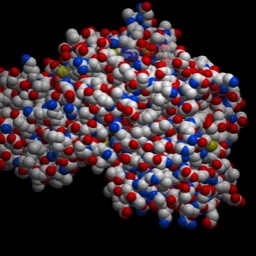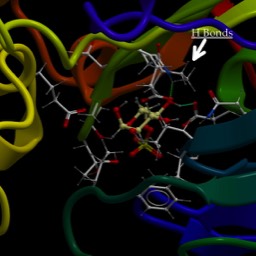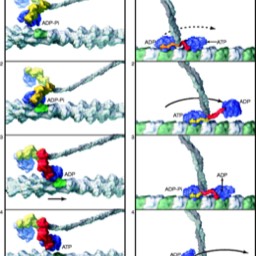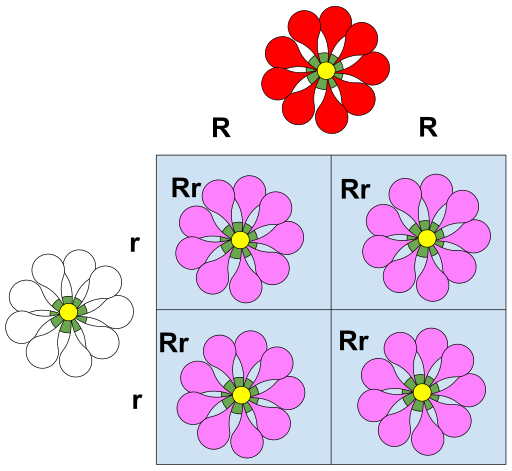
Intro Genetics and Meiosis
Introduction to Genetics
(Key terms will be in italics).
We learned about replication. Sometimes mistakes are made that affect a protein. These could be in the coding sequence or the regulatory sequences. That gives rise to variations. Let's look at some examples.
Types of small mutations.
Some changes to DNA are large rearrangements like deletions, insertions (such as the type in exon shuffling that can lead to new protein functions). But, also there are small, single-nucleotide changes, such as the one cited in the sickle cell disease question early in the year. Here are small alterations to DNA that can affect the protein made…and therefore the appearance of the individual:
Mis-sense mutation.
This is where a nucleotide is substituted and results in the wrong amino acid being encoded in the protein. An example of this is the glutamic acid (GAG) to Valine (GUG) in sickle cell disease. In the "THECATWASBADTHEDAYSHEBITTHEDOG" case, it might be "THEBATWASBADTHEDAYSHEBITTHEDOG"
You can still read it, but the sense of it has changed.
Frame-shift mutation: this inserts or deletes one or two bases so that you are no longer reading in the correct frame. So, "THETCATWASBADTHEDAYSHEBITTHEDOG" after THE, you read TCA TWA….everything is messed up after that.
Finally, there is something called a nonsense mutation, which is when a stop codon is created. So, if the UUG codon for Tryptophan was changed to UUA, it result in the protein being terminated early. Note that the frame shift mutations usually result in encountering a stop in the new frame pretty quickly.
You can also have "synonymous" mutations: a change to the DNA that does not change the protein. For example since GUA and GUU both encode valine, that switch would not change the protein.
This takes into account only mutations to the coding region. There are also mutations to promoters and other regulatory sequences, such as for blue eyes below.
One more thing, I forgot to mention signal peptides. These are sequences of amino acids at the amino terminus of the newly made protein that tell the ribosome that the protein is destined to be secreted or made in the membrane. It shouldn't surprise you that, again, we need both the structural data and signals to tell the machinery what to do.
Basic stuff
If you get this part, you can read through quickly. But, make sure you are getting it.
First, a general observation: offspring tend to look like parents. No surprises there. We say that traits are general descriptions of how an organism appears or behaves and that these traits are inherited from parents. The study of inheritance is called genetics.
What is a gene? I will use two definitions here, both of which are incomplete.
- A gene is the unit of inheritance. It is the thing that is passed from parent to offspring that results in the inherited trait.
- A gene is a stretch of DNA that encodes a protein and the regulatory sequences that tell the cell when and where the gene is turned “on” and the protein is made.
The physical location on a chromosome that contains a particular gene is called a locus (plural, “loci”). So, let’s pick blue eyes versus brown eyes as an example. It should be said that the details of the genetics of eye color are much more complicated than you may have been previously told. You can find a really good description of how it works here. However, there is a major gene involved in eye color, called “OCA2.” I’ll tell you what the protein it encodes is later. It is encoded by a stretch of DNA on chromosome 15. Like all humans, you have two copies of chromosome 15, one from Mom and one from Dad. A “map” of the chromosome is below. It is approximately 100,000,000 base pairs long and the OCA2 gene is located from base pair 28,000,020 to base pair 28,344,457 on chromosome 15. On every person’s chromosome 15, the gene for OCA2 is in that spot. This is its locus.
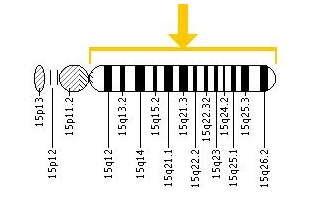
However, even though every one of us has a copy of OCA2 at the same spot on each of the two copies of chromosome 15, the exact sequence of the DNA may be different (due to inherited changes to the sequence in the DNA called mutations).
The different forms of the gene are called “alleles.” There is an allele associated with brown eyes and one with blue.
What does OCA2 do? Well, it encodes a protein that transports an amino acid called tyrosine, which is converted by a specific enzyme into a dark brown pigment called “melanin.” Melanin is the source of the brown color in our skin or hair, and increased melanin in cells in our skin leads to us getting a “tan.” There is no “blue” pigment in my eyes…just the lack of brown pigment in the front of my iris. If you were to cut into my eye, you would find I have melanin in the back of the iris (though, please don’t).
The problem with my eyes that leads to them being blue is where the transport protein is expressed…or, where it isn’t. The mutation associated with blue eyes is in the regulatory (promoter region) sequences around the sequence that encodes the protein. The transport protein is not expressed in the front part of the iris, no melanin gets put there and my eyes are blue.
So, let’s over simplify eye color and say that there is only “brown” and “blue.” Brown results from the transport protein being made in the front of the iris as well as in the back, so melanin is in both places.
Blue eyes result when the transport protein is not expressed in the front of the eye and less melanin is put there. (again, over simplified).
Blue eyes are recessive and brown eyes are dominant.
Consider this: suppose you have people that come in two varieties: ones that pour water on the floor and ones that don’t. If you have two people who don’t pour water in a room, the floor is dry. If you have two people who do pour water on the floor, the floor is wet. If you have one of each…the floor is still wet. The effect of the person pouring water on the floor is dominant to the effect of not pouring water.
Let’s suppose you got one copy of the “blue” allele from your mom and one copy for the “brown” allele from dad. Since the two copies of the locus contain different alleles, you are said to be heterozygous (having different alleles at the each of the two versions of that locus).
The copy you got from mom does not result in the transporter being made in the front of the eye…but the one from dad does, so you have the transporter there and the eyes are brown. The blue allele is busily not doing anything…but no one notices because the brown allele makes the protein. That’s why “blue” is recessive.
In order to have blue eyes, you have to have both copies of the gene be the form that does not function in the eye (just like to have a dry floor, you have to have both people in the room not pouring water on the floor). If you have two copies of the “blue” allele, no transporter, therefore no melanin in the front of the eye, therefore blue.
You are “homozygous” for the recessive allele. If we abbreviate the allele that results in expression of the transporter as “b” and the allele that results in proper expression in the front of the iris as “B,” you can have three possible arrangements of the alleles at your two loci.
B,B (homozygous for the dominant brown eyes);
B,b (heterozygous, one of each allele);
b,b (homozygous for the recessive allele)
We call this your “genotype.” Genotype tells you what two alleles at a particular locus you have.
BB and Bb both result in brown eyes. Brown eyes is the “phenotype,” the person has. Phenotype describes the actual trait.
Only the homozygous recessive (bb) results in blue eyes.
Meiosis
Here is a good video on Meiosis
The processes look fairly similar. In fact, meiosis II looks just like mitosis: Sister chromatids (really duplicated chromosomes) line up on the mitotic spindle and then separate. The different part is Meiosis I. Your cells are diploid (a complete set of chromosomes from Mom and another from Dad). Before you can pass your genetic information on to the next generation, cells of your germ-line (sperm or egg producing) must reduce the DNA precisely by half (and, of course, you have to finish college, get married and start a career etc).
It won’t do to just cut the amount of DNA in half. Each gamete must get one complete copy. Chromosomes are numbered from largest to smallest. So, chromosome 1 is the biggest. You have one of these from Mom and one from Dad. These are called homologous chromosomes. In Meiosis I, the duplicated homologous chromosomes pair up. So, both copies of chromosome 1, each really two copies of DNA as sister chromatids, will pair up, as will the two copies of chromosome 2 etc.
Meiosis 1 separates the mom copy of each from the dad. The assortment is random (each “mom” copy could go to either pole) The result will be a duplicated “haploid” cell, which has one duplicated copy of each chromosome. It could have mom’s chromosome 1 and Dad’s chromosome 2 or any combination.
In addition to this mixing up of mom’s and dad’s contribution, there is be some actual trading of DNA through a process called “crossing over” or “recombination,” which shuffles the genes a little during the time when homologous chromosomes are paired.
The videos show it pretty well.
Example Punnet squares involving a single locus:
Two "true breeding" populations.
"True breeding" is code for homozygous. Do you see why?
AA x aa
| Male/female | A | A |
| a | Aa | Aa |
| a | Aa | Aa |
Heterozygous by heterozygous
Aa x Aa
| Male/female | A | a |
| A | AA | Aa |
| a | Aa | aa |
You get the 1:2:1 distribution of genotypes. IF it is a trait inherited by simple dominance, then you get 3:1 dominant/recessive.
Heterozygous by homozygous recessive:
Aa x aa
| Male/female | A | a |
| a | Aa | aa |
| a | Aa | aa |

